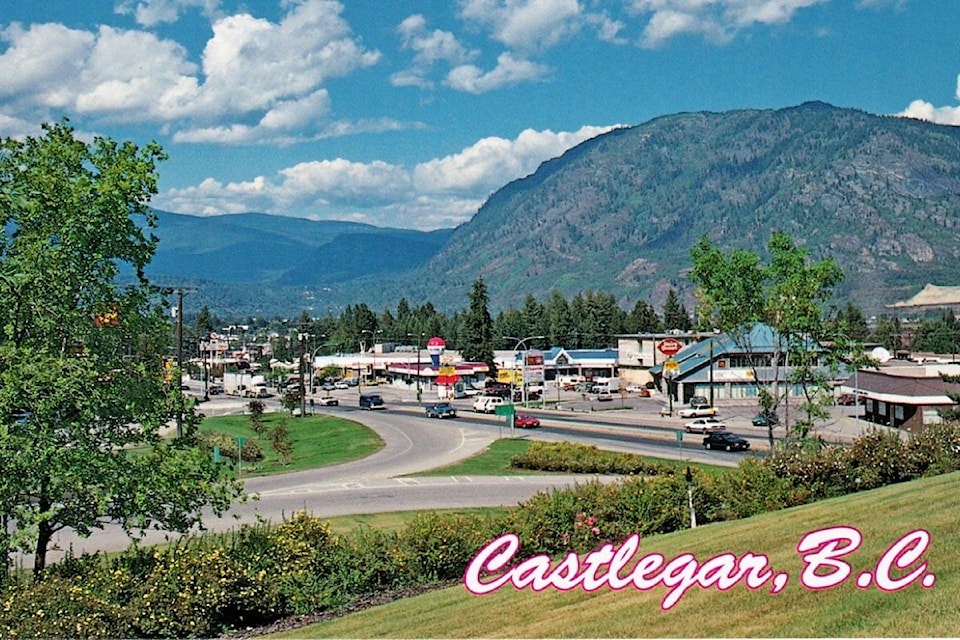A series on West Kootenay/Boundary place names
We’ve devoted the past two installments in this series to civic nicknames: Rossland is the Golden City or Canada’s Alpine City, Trail is the Silver City (formerly the Smelter City), and Nelson is the Queen City of the Kootenays, a title also claimed by Kaslo.
It wasn’t the only disputed name. Hub of the Kootenay is a rather generic appellation that Salmo, Castlegar, Nelson, Trail, Rossland, Creston, and Cranbrook have all claimed at various times.
Cranbrook was first out of the gate, described that way in a letter to the editor published in the Victoria Daily Times on March 4, 1889: “Cranbrook is the hub of the Kootenay district, and … all trails, roads, bridges, etc., to be of any use whatever must be in direct communication with Cranbrook …”
The Nelson Tribune of June 5, 1897 felt the construction of the Crow’s Nest railway would “make Nelson the hub of West Kootenay.”
The Chicago Inter Ocean wrote on July 2, 1899 that Rossland was “now a civilized city … The corduroys and overalls, the bushy bears, and the unkempt and yet picturesque prospector know[s] Rossland no more, and henceforth the hub of the golden Kootenays must be content with being the most prosperous city in the Dominion.”
Castlegar was called the Hub of Kootenay in the Trail News of March 21, 1908 while the Creston Review of March 4, 1909 said “Creston is bound to become the hub of the Kootenays” and the Trail Times of June 21, 1930 said the “modern Trail” was the hub of the Kootenays. The Vancouver Sun of April 20, 1935 also called Trail the “Hub of Kootenay’s prosperity.”
The Vancouver Province of April 14, 1929 said Ainsworth “was the hub of Kootenay in those [early] days.”
Eventually, however, Salmo firmly grasped the title and never let go, adopting it a semi-official slogan (along with “Home of the Stone Murals.”) The earliest known reference to Salmo as the hub is only from The Vancouver Sun of March 29, 1990 but a Google search today suggests it has little or no competition.
• Salmo, Castlegar, and Cranbrook have all been called the Crossroads of the Kootenays. Or Cross Roads of the Kootenays. In Castlegar’s case, it first appeared on the nameplate of the Castlegar News on June 30, 1949, although it’s not clear if the credit was due to publisher Les Campbell or someone else. It was being used on Castlegar Chamber of Commerce stationary by 1953.
In 1969’s A Book Pedlar in British Columbia, C.K. Morison wrote: “The Kiwanis Club of Castlegar has labelled the town the ‘Cross Roads of the Kootenays,’ and with some justification …”
But the Vancouver Province of Sept. 2, 1950 claimed “Cranbrook is at the crossroads of the Kootenays” and an ad in the Nelson Daily News pictorial and industrial magazine of March 19, 1960 called Salmo: “The future crossroads of the Kootenays” while another ad in the same publication simply called Castlegar “The Crossroads.”
By the time the March 12, 1965 industrial edition rolled around, the Kootenay Pass had opened, and Salmo was calling itself “the Crossroads of the Kootenays.”
Google it today, though, and you’ll find the nickname belongs exclusively to Castlegar. We can imagine a treaty signing where Castlegar agreed to stick to the crossroads and Salmo would remain the hub. That said, it has gone by the wayside in recent decades. A few businsses adopted it, including Crossroads Stationers and the Crossroads branch of Kootenay Savings. It also helped inform the design of the city’s coat of arms.
Castlegar had a few other nicknames too: Sunflower City is almost completely obsolete. It appears to date to the 1970s, when the city hosted the Sunflower festival. Best Dam City was a clever coinage playing on the nearby dams on the Columbia and Kootenay Rivers. It dates perhaps to the 1990s.
• Warfield is officially the Jewel of the Kootenays, a name that appeared in the Ashcroft Journal of Oct. 22, 1985, although it has also applied to Kokanee Glacier Park (The Vancouver Sun, Jan. 27, 1940), the Slocan River (Go&Do, Spring/Summer 2008), Kaslo (Nelson Daily News, July 16, 2009), Nelson and Kootenay Lake in general (Visitors’ Choice Nelson and Kootenay Lake 2011 guide), and Trout Lake (troutlakebc.com).
Larry Jacobson’s 2008 book Jewel of the Kootenays is actually about the Emerald mine near Salmo.
• Montrose is officially the Gateway to the Beaver Valley, a name that dates to at least 1992, when it appeared in the Rossland-Trail civic directory.
• Fruitvale is The Heart of the Beaver Valley. The phrase appeared in a letter issued by the Fruitvale homecoming committee, published in various BC newspapers beginning in January 1991: “Have you ever lived in Fruitvale, the heart of the beautiful Beaver Valley?” It was on the village stationery as of January 2009.
We’ll continue delving into the subject next week.
